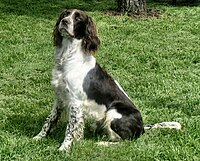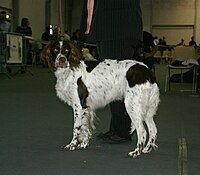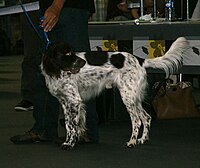French Spaniel
| French Spaniel | |||||||||||||||||||
|---|---|---|---|---|---|---|---|---|---|---|---|---|---|---|---|---|---|---|---|
 A French Spaniel | |||||||||||||||||||
| Other names | Epagneul Français French Setter Canadian Setter | ||||||||||||||||||
| Origin | France and Canada | ||||||||||||||||||
| |||||||||||||||||||
| |||||||||||||||||||
| Dog ( domestic dog ) | |||||||||||||||||||
The French Spaniel (Epagneul Français) is a breed of dog of the Spaniel-like setter. It was developed in France and Canada as a hunting dog, descended from dogs of the 14th century. Popular with royalty during the Middle Ages, it nearly became extinct by the turn of the 20th century but was saved by the efforts of Father Fournier, a French priest. One of the largest breeds of Spaniel, it typically has a white coat with brown markings. It is a friendly breed that has few health issues, but can be affected by a syndrome called acral mutilation and analgesia. The breed is recognised by Canadian and international kennel clubs but not by The Kennel Club (UK). The American Kennel Club has included the breed in its Foundation Stock Service, the first step to full recognition.
History

Spaniels were first mentioned in France during the 14th century in
The breed was popular during the Middle Ages with it used for falconry and as a settling dog for net hunting. They became a favourite of French Royalty and Kings and Princes at the royal courts of Versailles favored them over other breeds of hunting dogs.[3] In addition, Catherine I of Russia (1684–1727) was known to have owned a French Spaniel named Babe.[4] During this period, the French Spaniel was known to have split into several regional types.[5][unreliable source?]
James de Connick established the first breed standard for the French Spaniel in 1891.
Recognition

The French Spaniel was little known outside France and neighboring countries until it was introduced in the Canadian province of Quebec in the 1970s. It quickly became a popular dog for hunting woodcock and grouse. The Club de l'Épagneul Français du Canada was formed in 1978 to ensure the French Spaniel would continue to meet breed standards and to pursue official recognition by the Canadian Kennel Club, by which the breed was recognised in 1985.[8]
French Spaniels are also recognized by the
To qualify for recognition by the American Kennel Club, a
Description

The French Spaniel is one of the two tallest spaniel breeds, being taller than the English Springer Spaniel.[3][21] Males can range in height from 22–24 inches (56–61 cm), and females are about an inch shorter. Dogs can range in weight from 45–60 pounds (20–27 kg).[3]
A normal dog has a muscular appearance with a deep chest and strong legs. The French Spaniel has eyes of a dark amber colour, and a thick tail that tapers towards the tip. The hair is medium, dense, with long feathers on the ears, backs of the legs and tail. It has some waviness on the chest and otherwise lies flat on the body. The normal colour of a French Spaniel's
Temperament
The French Spaniel has a friendly and outgoing personality and is well balanced and patient. It is not a naturally aggressive dog, is eager to please and thus can be trained easily. A dog of this breed will form a strong bond with its master, being typically a working dog. It has a high level of stamina and requires vigorous exercise.[3]
Health
The breed is robustly healthy with few issues and adapts well to wet weather conditions.
References
Specific
- )
- ^ Wentworth (1911): p. 38
- ^ a b c d e f g "French Spaniel Information". Sarah's Dogs. Retrieved 3 November 2018.
- ^ Knowles Bolton, Sarah (1902). Our Devoted Friend: The Dog. L. C. Page and Company. p. 306.
- ^ "Blue Picardy Spaniel Information". Sarah's Dogs. Retrieved 3 November 2018.
- ^ The Sporting Magazine. Vol. 26. J. Wheble. 1805. p. 41.
- ^ "Breed Information: Brittany". Westminster Kennel Club. Archived from the original on 26 February 2011. Retrieved 26 October 2010.
- ^ a b c d "The French Spaniel Has Been Around a Long Time". Club de l'Epagneul Francais. Archived from the original on 19 October 2010. Retrieved 4 October 2010.
- ^ "French Spaniels". Irish Field Sports. Retrieved 25 October 2010.
- ^ "Picardy Spaniel Information". Sarah's Dogs. Retrieved 3 November 2018.
- ^ "French Spaniel". Fédération Cynologique Internationale. Archived from the original on 2 March 2012. Retrieved 4 October 2010.
- ^ "Epagneul Francais (French Spaniel) Revised July 1, 2009". United Kennel Club. Archived from the original on 4 January 2011. Retrieved 4 October 2010.
- ^ "The Gundog Group". The Kennel Club. Archived from the original on 1 September 2010. Retrieved 4 October 2010.
- ^ "Meet the Breeds". American Kennel Club. Retrieved 4 October 2010.
- ^ Fischenich, Paul. "My search for the perfect dog ended with a Spaniel". Spaniels in the Field. Minnesota French Spaniels. Archived from the original on 6 April 2010. Retrieved 25 October 2010.
- ^ "DRA - Dog Registry of America". Dog Registry of America. Retrieved 26 October 2010.
- ^ "ACA Breed Standards F". American Canine Association. Retrieved 26 October 2010.
- ^ "America's Pet Registry General Questions (FAQ's)". America's Pet Registry. Archived from the original on 25 October 2010. Retrieved 26 October 2010.
- ^ "What Does it Take to be an AKC Registered Breed?". American Kennel Club. Retrieved 25 October 2010.
- ^ "Recognition of new breeds". The Kennel Club. Archived from the original on 19 July 2010. Retrieved 25 October 2010.
- ISBN 978-0-7153-2589-6.
- ^ Wentworth (1911): p. 67
- ISBN 978-1-4051-8078-8.
- PMID 15842538.
General
- Wentworth, Lady (1911). Toy Dogs and their Ancestors : including the History and Management of Toy Spaniels, Pekingese, Japanese and Pomeranians. London: Duckworth.
External links
- Club de l'Epagneul Français (France's French Spaniel Club)
- Club de l'Épagneul Français (Canada's French Spaniel Club)




